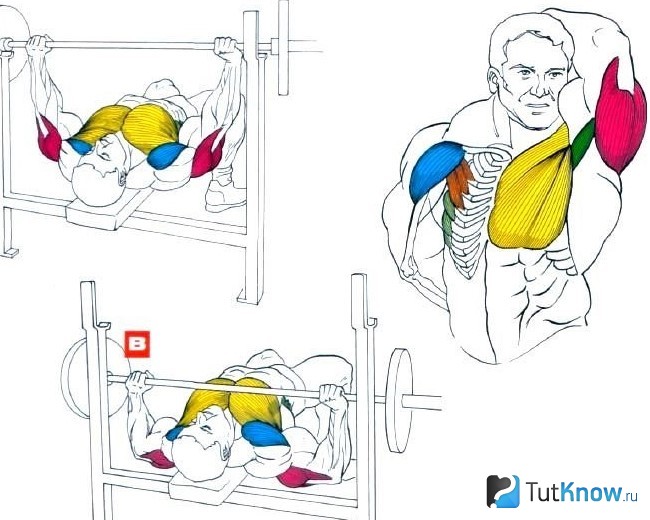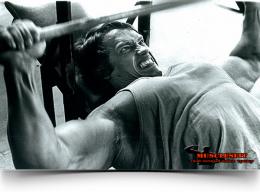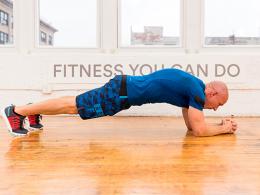How to increase bench press by 20 kg per month?
If your goal is to conquer weights in the bench press? Then be sure to familiarize yourself with the training methodology, which will increase the current performance by 20 kg.
Before moving on to a discussion of the training methodology itself, you should talk about the exercise itself, or rather, some of the subtleties that will help you improve your personal performance. Let's start with grip width, as this is a highly debated topic. As many athletes know, the grip can be medium narrow to wide.
You are now faced with the task of choosing the best for yourself, for which you should perform a small exercise. Sit on the floor and take a comfortable position for you to do the bench press. Ask a friend to measure the distance between your hands. This will be your optimal grip, which should be used in the future. You may think that this is not a scientific approach, but your body knows best how it will feel comfortable doing the press.
The second secret lies in the direction of the movement. Most often, athletes squeeze the sports equipment straight and up. However, if you look at professional powerlifters, they perform this movement differently - up and at a slight angle to the head.
And the last nuance of the bench press is arching the back. Of course, this allows you to use more working weight, but this happens only due to a reduction in the distance between the chest and the sports equipment. But this will not affect the increase in power indicators in any way. In turn, in order to progress, you need to develop precisely strength.
Bench training method

It should be said right away that training according to this method should be carried out only after performing warm-up sets. It is better to start with an empty bar, slowly doing 5 to 6 repetitions. Then do 3 to 4 more light weight reps for 4 sets. After a three-minute pause, you can start training directly.
The technique was created for the development of the muscles of the whole body and you do not need to make major adjustments to the training program. The technique is based on the principle of "pull-push", which implies the simultaneous training on one day of all the muscles that perform pushing movements, and on the other - pulling. The first group includes the muscles of the chest, shoulder girdle and triceps. The back and biceps belong to the second group, as do the legs.
This is due to the fact that the duration of the training of the back and biceps is shorter in comparison with the pushing muscle group. Legs should be trained once a week. The muscles of the legs are large and they train quite hard, requiring a lot of energy for this. If you train your legs more often, then you may not achieve the desired result in the press.
Most training systems involve the maximum load on the muscles, followed by rest to restore the body. The technique described today is based on a gradual increase in working weight. You do not have to increase the weight in each session, but you need to do this gradually, thereby creating a more real increase in strength and muscle mass.
At the first stage, this technique involves a two-day split, and you have no choice. The training schedule is rigid and must be followed. Unless of course you want to achieve your goal in the bench press.
The training program is quite simple. Basic exercises should be performed for each muscle group. At the same time, there will be auxiliary exercises for the development of the back, deltas, biceps and triceps.
Also, do not increase the load yourself and follow the recommendations. Otherwise, this can lead to overtraining, but it is better that the muscles are slightly undertrained. At the same time, you should not be afraid that you will lose muscle volume or strength indicators will decrease.
On the contrary, after the transition to normal training, they will increase. When training the chest, there will be some nuances, which we will talk about later. For example, in one lesson you need to perform three sets of 1, 2 and 3 repetitions, and in another - 4, 5 and 6 repetitions.
If you haven't done sets with less than four sets before, now you have to do it. Such approaches lead to an increase in strength indicators, and this is exactly what we are trying to achieve.
The same can be said about the intensity of training. When performing sets with a low number of repetitions, it is necessary to work with almost maximum weights, which also increases the intensity of training. You should remember that the closer the working weight is to the repeated maximum, the higher the intensity of the training will be. At the same time, the volume of muscles will not increase so quickly, but the strength indicators will grow perfectly.
In addition to the fact that there will be leg training once a week, you will have to slightly reduce the load on the shoulder girdle. The training program includes several types of overhead presses and the anterior deltas do not need further loading. Shoulder girdle training is given Monday and Friday.
On the first day of classes, you should perform swing movements with dumbbells to the sides, and on the second day, the muscles that rotate the shoulder joint will develop. To improve your performance in the bench press, you need to have strong shoulder joints. Each training session will last about an hour. It should not be extended. And now about the exercises themselves.
Monday
- Bench press in the prone position;
- Dumbbell bench press in the prone position;
- Mahi to the sides with dumbbells;
- French press.
Wednesday
- Block thrust in the direction of the chest, the grip is narrow;
- Tilt rods;
- Curl with barbell for biceps.
Friday
- Exercises for rotating shoulder muscles;
- Bench press in the prone position;
- Push-ups on bars.
Saturday
- Squats;
- Leg press;
- Leg curl;
- Block pull in the direction of the chest, reverse grip;
- Bent over dumbbell row;
- Bending the arms with dumbbells in a sitting position.






